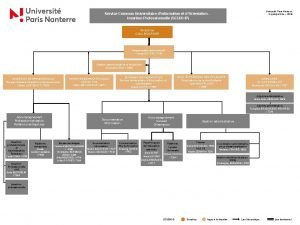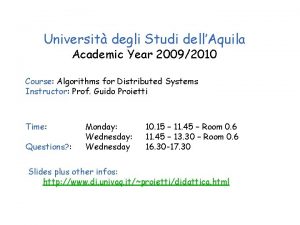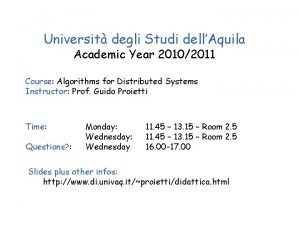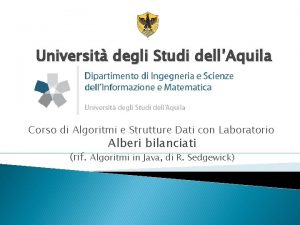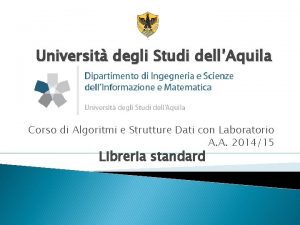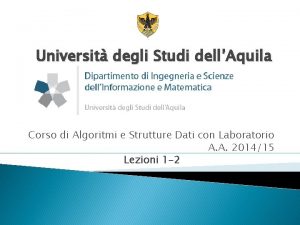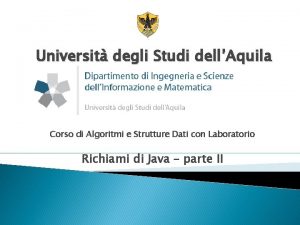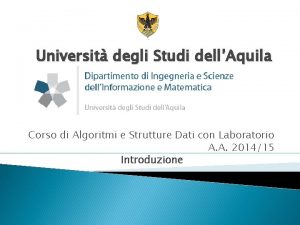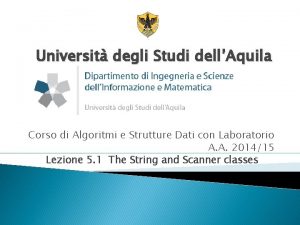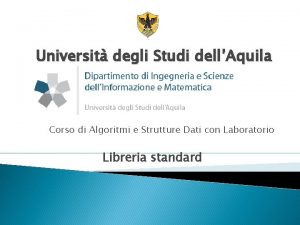Universit degli Studi dellAquila Academic Year 20192020 Course






















- Slides: 22

Università degli Studi dell’Aquila Academic Year 2019/2020 Course: Non-cooperative networks (3 CFU) (this course is integrated within the NEDAS curriculum with ‘’Social networks’’ (3 CFU), by Dott. Gianpiero Monaco, to form the ‘’Autonomous Networks’’ course) Instructor: Prof. Guido Proietti Schedule: Questions? : Wednesday: Thursday: Tuesday 9. 30 – 11. 15 – Room A 1. 2 11. 30 – 13. 15 – Room A 1. 1 16. 30 - 18. 30 (or send an email to guido. proietti@univaq. it) Slides plus other infos: http: //people. disim. univaq. it/guido. proietti/2019. html

Autonomous versus non-autonomous (communication) networks • • In a very general sense, an autonomus network is composed by many independent entities which interact by means of some common infrastructure (e. g. , a physical communication network), with no any central authority dictating how these entities should actually behave Some examples of autonomous networks: Mobile Ad hoc Networks (Wireless) Sensor Networks Social Networks …

The mother of all autonomous networks: the Internet

Lack of cooperativeness in large networks Large autonomous networks (e. g. , Internet) are often built/controlled/used by diverse and competitive entities: Entities may for instance own different components of the network, and hold private information about the cost of using them, or they may use selfishly some physical component of an underlying network we call the resulting network non-cooperative, to emphasize this competitive behavior n The classic network optimization field of research (where selfishness is not considered) does not fit properly here to study computational and design problems!

Three main ingredients in the course: Networks + Algorithms + Game Theory We will be concerned with the computational (i. e. , algorithmic) and game-theoretic aspects of a Non-Cooperative Network (NCN). In other words, we will analyze some classic network optimization problems (e. g. , multicommodity flow, network design, shortest paths, minimum spanning tree, etc. ) by assuming that each selfish entity (say, agent or player) chooses strategically and non-cooperatively how to behave, by aiming to maximize his personal benefit. Our topic is a subfield of the larger emerging Algorithmic Game. Theory (AGT) field.

Course structure and exams FIRST PART: Strategic equilibria theory in NCN 1. Nash equilibria 2. Selfish routing 3. Network Design games 4. Network Creation games SECOND PART: Implementation theory in NCN 1. Algorithmic mechanism design (AMD) 2. AMD for some basic graph optimization problems Written Examination (week November 4 -8): 10 multiple-choice tests, plus an openanswer question. IF a passing grade is earned, THEN this can be EITHER maintained, OR it can be immediately questioned through a quick-oral examination. In both cases, the final mark will be frozen until January, when it will be registered (possibly after an integration with the ‘Social Networks’’ course). OTHERWISE, you will directly access to the next described step. Oral Examination: this will be concerned with the whole program. There will be fixed a total of 6 dates, namely: • 3 in January-February • 2 in June-July • 1 in September For those enrolled in the NEDAS curriculum, there will be a single final grade as a result of the grades obtained in this course and in the ‘Social Networks’’ course (Dott. Gianpiero Monaco); the corresponding exams can be done separately, but they must be given within the same calendar year (e. g. , 2020)

Suggested readings n n Algorithmic Game Theory, Edited by Noam Nisan, Tim Roughgarden, Eva Tardos, and Vijay V. Vazirani, Cambridge University Press. Blog by Noam Nisan http: //agtb. wordpress. com/

Algorithmic Game Theory: an Introduction

Two Research Traditions n Theory of Algorithms: computational issues n n n What can be feasibly computed? How much it is intrinsically difficult a problem? How long does it take to compute a solution? Which is the quality of a computed solution? Centralized or distributed computational models Game Theory: interaction between self-interested individuals n n What is the outcome of the interaction? Which social goals are compatible with selfishness?

Different Assumptions n Theory of Algorithms (in distributed systems): n n n Processors are obedient, faulty (i. e. , crash), adversarial (i. e. , Byzantine), or they compete without being strategic (e. g. , concurrent systems) Large systems, limited computational resources Game Theory: n n Players are strategic (selfish) Small systems, unlimited computational resources

The Internet World n Users often selfish n n n Have their own individual goals Own network components Internet scale n n Massive systems Limited communication/computational resources Both strategic and computational issues!

Fundamental question n How the computational aspects of a strategic distributed system should be addressed? Algorithmic Theory of Game = + Game Theory Algorithms Theory

Basics of Game Theory n A game consists of: n n n A set of players (or agents) A specification of the information available to each player A set of rules of encounter: Who should act when, and what are the possible actions (strategies) A specification of payoffs for each possible outcome (combination of strategies) of the game Game Theory attempts to predict the final outcomes (or solutions) of the game by taking into account the individual behavior of the players

Solution concept How do we establish that an outcome is a solution? Among the possible outcomes of a game, those enjoying the following property play a fundamental role: n Equilibrium solution: strategy combination in which players are not willing to change their state. But this is quite informal: what does it rationally mean that a player does not want to change his state? In the Homo Economicus model, this makes sense when he has selected a strategy that maximizes his individual wealth, knowing that other players are also doing the same.

Roadmap n n We will focus on two prominent types of equilibria: Nash Equilibria (NE) and Dominant Strategy Equilibria (DSE) Computational Aspects of Nash Equilibria n n Can a NE be feasibly computed, once it exists? What about the “quality” of a NE? Cases study: Network Flow Games (i. e. , selfish routing in Internet), Network Design Games, Network Creation Games (Algorithmic) Mechanism Design in DSE n n n Which social goals can be (efficiently) implemented in a strategic distributed system? Strategy-proof mechanisms in DSE: Vickrey-Clarke-Groves (VCG) -mechanisms and one-parameter mechanisms Cases study: Shortest Path, Minimum Spanning Tree, Singlesource Shortest-path Tree

FIRST PART: Dominant strategy and Nash Equilibria

(Some) Types of games n n n Cooperative/Non-cooperative Symmetric/Asymmetric (for 2 -player games) Zero sum/Non-zero sum Simultaneous/Sequential Perfect information/Imperfect information One-shot/Repeated

Games in Normal-Form We start by considering simultaneous, perfectinformation and non-cooperative games. These games are usually represented explicitly by listing all possible strategies and corresponding payoffs of all players (this is the so-called normal–form); more formally, we have: n A set of N rational players n For each player i, a strategy set Si n A payoff matrix: for each strategy combination (s 1, s 2, …, s. N), where si Si, a corresponding payoff vector (p 1, p 2, …, p. N), where pi is the payoff of player i |S 1| |S 2| … |SN| payoff matrix

A famous game: the Prisoner’s Dilemma Non-cooperative, symmetric, non-zero sum, simultaneous, perfect information, one-shot, 2 -player game Prisoner II Don’t Implicate 1, 1 6, 0 Implicate 0, 6 5, 5 Strategy Set Prisoner I Strategy Set Payoffs (for this game, these are years in jail, so they should be seen as a cost that a player wants to minimize)

Prisoner I’s decision Prisoner II Prisoner I Don’t Implicate n Prisoner I’s decision: n n n Don’t Implicate 1, 1 6, 0 0, 6 5, 5 If II chooses Don’t Implicate then it is best to Implicate If II chooses Implicate then it is best to Implicate It is best to Implicate for I, regardless of what II does: Dominant Strategy

Prisoner II’s decision Prisoner II Don’t Implicate 1, 1 6, 0 0, 6 5, 5 Prisoner I Don’t Implicate n Prisoner II’s decision: n n n If I chooses Don’t Implicate then it is best to Implicate If I chooses Implicate then it is best to Implicate It is best to Implicate for II, regardless of what I does: Dominant Strategy

Hence… Prisoner II Prisoner I n n Don’t Implicate 1, 1 6, 0 Implicate 0, 6 5, 5 It is best for both to implicate regardless of what the other one does Implicate is a Dominant Strategy for both (Implicate, Implicate) becomes the Dominant Strategy Equilibrium Remark: If they might collaborate, then it would be beneficial for both to Not Implicate, but in the provided setting the players would reciprocally betray each other, as both have incentive to deviate
 Universit
Universit Universit sherbrooke
Universit sherbrooke Erasmus universit
Erasmus universit London universit
London universit Organigramme nanterre
Organigramme nanterre Università degli studi roma tre mascotte
Università degli studi roma tre mascotte Kit dello studente erasmus unige
Kit dello studente erasmus unige Ingegneria gestionale parthenope
Ingegneria gestionale parthenope Kiro farmacia
Kiro farmacia Università degli studi di firenze psicologia
Università degli studi di firenze psicologia Uci ics academic advising
Uci ics academic advising Academic year in freiburg
Academic year in freiburg Academic year in america
Academic year in america Academic year in poland
Academic year in poland It academy microsoft
It academy microsoft Microsoft official academic course microsoft excel 2016
Microsoft official academic course microsoft excel 2016 Short authentic academic text
Short authentic academic text Microsoft official academic course microsoft word 2016
Microsoft official academic course microsoft word 2016 Microsoft official academic course microsoft word 2016
Microsoft official academic course microsoft word 2016 Reception leavers poem
Reception leavers poem What is half brick wall
What is half brick wall Course number and title
Course number and title Chaine parallèle muscle
Chaine parallèle muscle




